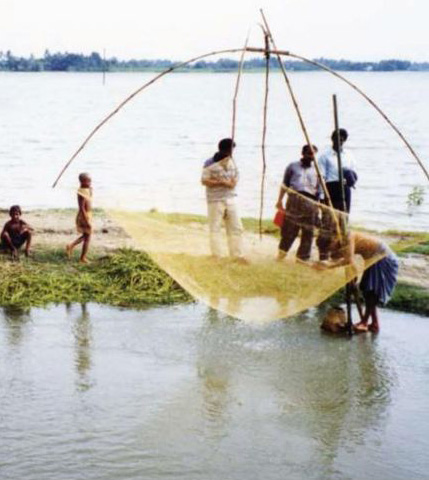Difference between revisions of "Finger pond"
| Line 1: | Line 1: | ||
{{stub}} | {{stub}} | ||
[[Image:Finger_pond_icon.png|right]] | [[Image:Finger_pond_icon.png|right]] | ||
| − | [[Image:Finger ponds.JPG|thumb|right| | + | [[Image:Finger ponds.JPG|thumb|right|250px|Finger pond]] |
Finger ponds use innovative techniques to enhance the natural productivity of wetlands and floodplains. The ponds (body of water smaller than a lake) consist of stretched artificial ponds 5 to 12 m long, extending into the wetland like fingers, hence the name. Finger ponds are excavated at the upstream edge of naturally occurring wetlands or floodplains and are lined with PVC plastic to prevent the water running out. They fill up during the flood cycle, and trap fish within them as the flooding recedes. | Finger ponds use innovative techniques to enhance the natural productivity of wetlands and floodplains. The ponds (body of water smaller than a lake) consist of stretched artificial ponds 5 to 12 m long, extending into the wetland like fingers, hence the name. Finger ponds are excavated at the upstream edge of naturally occurring wetlands or floodplains and are lined with PVC plastic to prevent the water running out. They fill up during the flood cycle, and trap fish within them as the flooding recedes. | ||
Fish are grown in the ponds during the dry season and can be caught to provide additional protein for local communities. The ponds can be enriched with manure. Meanwhile the land between the ponds is cultivated with seasonal crops. Pilot projects with finger ponds are being undertaken to assess their potential productivity, suitability and sustainability, taking into account natural and socio-economic aspects. Water that otherwise would run off or evaporate is now stored in these finger ponds during the dry periods. The annual inundation provides opportunities for aquaculture, fish cultivation and small-scale crop cultivation through irrigation. | Fish are grown in the ponds during the dry season and can be caught to provide additional protein for local communities. The ponds can be enriched with manure. Meanwhile the land between the ponds is cultivated with seasonal crops. Pilot projects with finger ponds are being undertaken to assess their potential productivity, suitability and sustainability, taking into account natural and socio-economic aspects. Water that otherwise would run off or evaporate is now stored in these finger ponds during the dry periods. The annual inundation provides opportunities for aquaculture, fish cultivation and small-scale crop cultivation through irrigation. | ||
| + | ==Suitable conditions== | ||
| + | *Wetlands or floodplains where water collects naturally. | ||
| + | *The local morphological situation dictates the specific requirements, costs and time needed for excavating the ponds. | ||
{| border="1" cellpadding="5" cellspacing="0" align="center" | {| border="1" cellpadding="5" cellspacing="0" align="center" | ||
| Line 18: | Line 21: | ||
<br> | <br> | ||
|} | |} | ||
| − | |||
| − | |||
| − | |||
| − | |||
| − | |||
| − | |||
==Construction, operations and maintenance== | ==Construction, operations and maintenance== | ||
Revision as of 00:16, 30 April 2012
| |
Finger ponds use innovative techniques to enhance the natural productivity of wetlands and floodplains. The ponds (body of water smaller than a lake) consist of stretched artificial ponds 5 to 12 m long, extending into the wetland like fingers, hence the name. Finger ponds are excavated at the upstream edge of naturally occurring wetlands or floodplains and are lined with PVC plastic to prevent the water running out. They fill up during the flood cycle, and trap fish within them as the flooding recedes.
Fish are grown in the ponds during the dry season and can be caught to provide additional protein for local communities. The ponds can be enriched with manure. Meanwhile the land between the ponds is cultivated with seasonal crops. Pilot projects with finger ponds are being undertaken to assess their potential productivity, suitability and sustainability, taking into account natural and socio-economic aspects. Water that otherwise would run off or evaporate is now stored in these finger ponds during the dry periods. The annual inundation provides opportunities for aquaculture, fish cultivation and small-scale crop cultivation through irrigation.
Contents
Suitable conditions
- Wetlands or floodplains where water collects naturally.
- The local morphological situation dictates the specific requirements, costs and time needed for excavating the ponds.
| Advantages | Disadvantages |
|---|---|
| Allows fish cultivation Provide additional protein |
|
Construction, operations and maintenance
- Maintenance consists of cleaning or desilting the ponds by swabbing the pond bottom.
Costs
Depending on local situation and size of the ponds.

